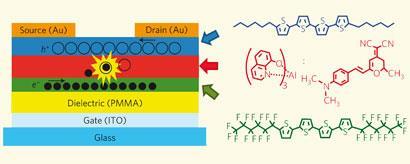Italian scientists develop organic light-emitting transistors that are more efficient than organic light-emitting diodes
Scientists in Italy have developed organic light-emitting transistors (OLETs) that are more efficient light sources than organic light-emitting diodes (OLEDs), and could be used in much sought after electrically pumped organic laser devices.
An OLED is an organic semiconductor device consisting of a thin film that emits light when a current is applied between two electrodes. OLEDs are used in many applications including lighting and electronic displays, but they are not suitable for organic laser applications as exciton-charge interactions and photon loss at the electrodes reduce their efficiency.
Scientists have been trying to develop electrically pumped organic lasers using transistors - semiconductor devices used to amplify and switch electronic signals - that allow very high efficiency and no loss of light. These lasers could then be used in fibre optics applications in the telecommunications industry.
A team led by Raffaella Capelli at the Institute of Nanostructured Materials in Bologna seems to have designed an OLET that displays a micrometer-sized light source with light generation kept separate from the electrical current, which helps maintain a bright and efficient light.

OLETs are optoelectronic devices that have a thin-film transistor structure and can generate light. Capelli’s device consists of three organic film layers between two electrodes. ’Every layer of the device is dedicated to a single function,’ says Stefano Toffanin, one of Capelli’s colleagues.
One layer of the device transports electrons between the electrodes in one direction, whilst the second layer carries the positive charge or hole transport - holes created by the electrons in the first layer - in the opposite direction. The final layer emits the light. ’The advantage is that the light formation region is not in the flowing current so quenching due to the current is prevented,’ explains Capelli.
The OLETs have ’a very impressive’ external quantum efficiency of 5 per cent, says Alasdair Campbell, an expert in OLETs at Imperial College, London. ’This greatly exceeds that of previous OLETs and is also twice the efficiency of the equivalent optimised small molecule OLED using the same materials. This is a very important efficiency milestone,’ he adds.
Capelli and her team now hope to develop these OLETs for uses in electrically pumped lasers in the near future.
Mike Brown
References
et alNature Materials, 2010, DOI: 10.1038/NMAT2751






No comments yet